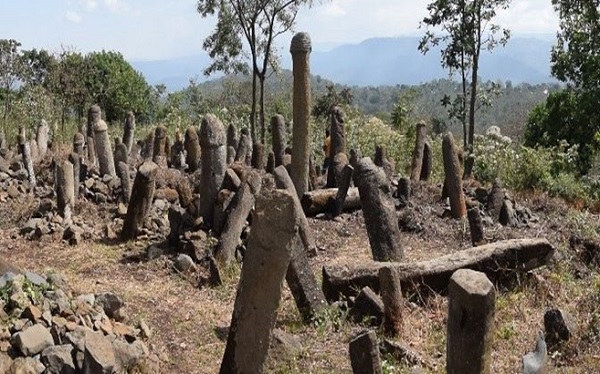
BY GIRMACHEW GASHAW
Ethiopia is a country blessed with historical, cultural, natural, and manmade resources. However, many of the resources have not been cultivated in a way to get economic advantage from them.
Hundreds of megalithic stele sites have been reported from the north, central and southern parts of Ethiopia. Despite this, limited scientific research has been conducted at stele sites in Ethiopia, specifically in the southern part of the country. Of the tangible heritages, Megalith stele is listed as one of the attractions that have been used to construct a prehistoric structure or monument, either alone or together with other stones.
The major megalithic sites of Ethiopia are found in Gedeo Zone, Gurage Zone and Sidama Zone. So far, Tiya was the lonely attraction sites registered under UNESCO heritage list. Stele, tumuli and dolmens are the common megalithic monuments found in Ethiopia. However, except Tiya, the remaining sites were not developed so as to be tourist attraction that can generate foreign currency.
Emphasis was given to the megalithic stelae of south Ethiopia, especially the Gedeo zone, for the region contains the largest number and highest concentration of megalithic carved stele known throughout Africa. Southern Ethiopia is also one of the few places in the world where people still practice stelae construction or actively engage with the constructed stele landscape.
Archaeological survey and test excavation was conducted in one of the ancient megalithic stele sites in south Ethiopia, Sakaro Sodo. The Sakaro Sodo stele site is situated in Gedeo zone, which is known to have the largest number and highest concentration of megalithic stele monuments in Africa, with an estimate of more than 10,000 stelae in sixty or more sites.
At present various tasks are now underway to get more than 6,000 Megalithic Stelae registered as World Heritage Sites, according to Authority for Research and Conservation of the Cultural Heritage.
The report indicated that there are more than 6,000 Megalithic stelae in Gedeo landscape in Southern part of Ethiopia. These stelae are the oldest in East Africa. Accordingly, efforts are well underway to get the more than 6,000 Megalithic Stelae registered as World Heritage Site by the United Nations Education, Science and Cultural Organization (UNESCO).
Following the visit to Gedeo natural and cultural heritages, Deputy Director General at the Authority for Research and Conservation of the Cultural Heritage Hiwot Hailu said our forefathers have kept the Gedeo cultural landscape heritage using indigenous knowledge for the posterity to learn from it. Citing that the Gedeo Landscape heritage is
one of the showcases of Ethiopia’s ancient civilizations, she said the heritage is being used as a great input for researchers. The protected forest in the Gedeo landscape is an exemplary for green legacy programs. Recall that the Gedeo experience provides a unique opportunity for the understanding of human environment relationship that is maintained through indigenous institutions, values and practices.
While many of the monoliths have fallen and/or are undecorated, a few have intricately wrought faces and other anthropomorphic designs carved into the stone that can be seen today.
Existing archaeological, ethnographic, and living megalithic stele traditions in the region suggest that the oldest stele sites were likely created for two purposes: to commemorate the transfer of power from one generation to the next or to record and commemorate group achievement.
Prior to the current work, only one absolute date was available (850 years ago) from a stele site in the Gedeo zone, suggesting the monuments began to be constructed in the region approximately a millennium ago.
“This is one of the most understudied archaeological sites in the world, and we wanted to change that,” explained Dr. Ashenafi Zena, a researcher with the State Historical Society of North Dakota and Hawassa University. Dr. Zena and colleagues used advanced radiocarbon dating to determine the megalithic stelae at the Sakaro Sodo site were likely created sometime during the first century CE.
They also found that, obsidian artifacts from the site originated some 300 km (186 miles) away in northern Kenya, illustrating that the people at Sakaro Sodo obtained most of their obsidian raw materials through some form of exchange or trade.
While little is known about the pastoral and/or agricultural people who populated the Sakaro Sodo region at the turn of the first millennium, the new construction dates of the stele monuments appear to coincide with the arrival of domesticated animals in the region and the beginnings of more complex social and economic systems.
“One of the reasons why this research is important is because it has the potential to shed new light on what the earliest people in this area were doing for a living as well as what their cultural and social practices were,” said Professor Andrew Duff, an anthropologist at Washington State University.
The activity of the authority would further be supported until the heritage site registered in UNESCO’s heritage list. The area where the heritages are found should also be developed in line with the registration process so as to get benefit out of it
. The Ethiopian Herald January 3/2023





